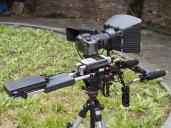
Video-Friendly Lenses for Lumix DSLRs
-
Really? Show me a photo.
-
-
BTW Zeiss CP.2 lenses are readily video friendly. It meets @LPowell's criteria list.
-
+1. I totally agree with you.
It's useful to know which lenses are readily video friendly. That's all ;) -
For that matter, are Carl Zeiss CP lenses video friendly? I remember they don't come cheap, but filmmakers seem to like using them for some reason.
There are always alternative ways to shade the lens. I have seen pp fix on matte boxes but there are no lenses or filters in the grooves. Posers?
I guess when you really need to get a job done, you will find a way -
Many SLR lenses are great. But mostly not video friendly. e.g. Try to use the Nokton 25mm 0.95 with a matte box and 4x4 filters. Of course you could use a Fader ND filter and a hood. It works. But this topic is about "readily" video friendly lenses.
When a maker claims for video optimized lens, it's gotta have a fixed length barrel. -
Voigtlander has a 15mm ultra wide prime. It's on Leica M mount. Check it out
-
Has anyone picked up the samyang/rokinon/bower 14mm2.8?
right now I'm using all olympus zuiko om mount primes, mainly the 24/2.8 and a 55/1.2, working great, but I lack a wide lens -
I read on another forum how some of these techkies tried to argue about the diameter of the Nokton, and whether it gives a true 25m when fixed on m4/3.
At the end of the day, any lens is just a piece of ground glass crafted to certain levels of perfection. How well it performs in reality is really up to the user.
So stop splitting hairs, go get a life, and a lens, even a $50 one, and start getting creative! -
I use legacy primes extensively on the GH2, and I concur with Markussen that the Contax Zeiss 50mm f1.7 does yield tremendous images - creamy, visuals are very sharp in the centre only to taper off in lovely bokeh. I compare this with the Canon FD f1.4, another very fast lens; both have very thin DOF, but I like the Zeiss quite a bit better.
I also use Leicas, and Voigtlanders and they blow me away despite all the cropping. There's also the venerable Nokton 25mm f0.95, the one lens you must have in yr kit if you disregard all the rest. I use this as a general lens, and almost always stick to it as much as possible. Just vary my focal distances, until of course I am forced to go really wide, like shooting landscape or buildings.
Speaking of 50mm lenses, check out also the Noktor Hyperprime. Another very fast lens that you would use to make films of cinematic quality.
When you pair a Nokton or Leica, or Zeiss, with the hacked patch, you do get something that far exceeds the 5D, IMHO. I have shot more than 20 projects on the 5D; in fact i was amongst the first to adopt it when it was still shooting only in NTSC (I live in PAL land). But I have since traded it for the GH2, and never looked back. The 5D may be a full frame camera but many pp don't realise that its sensor actually functions at half its optimal value when recording video (thus all the issues with moire et al).
I can't wait for the day when Zeiss or Leica finally starts making m4/3 lenses. -
@LPowell
great overview, I do a lot with my Contax CarlZeiss 28/2.8 50/1.7 135/2.8 and I am impressed by the performance, but I do have no comparizon to other vintage lenses... these lenses are NOT in your list?!?
IMHO compared to Lumix G 14-45 and 14-140 contrast and sharpness on the Lumix lenses is more appearent especially for Photos, for Video the CarlZeiss lenses bring more "reality", less plastic look.... for Portraits the 50mm 1.7 gives great DOF/blurr and gives the object more "identity"
any professional experiences??
thanks in advance
Kurt -
@LPowell
Just a shout for all the great contributions to the hack and also, you are an excellent writer -- your posts are always lucid and eloquent. I think you need your own blog by now. -
Any thoughts on the Tamron 28-75 2.8?
-
Tokina AT-X 116 Pro 11-16mm f2.8
This is a very good lens, good quality also in HD. It is heavy, and the front lens is quite large, mounted on a GH1 looks even bigger. I bought mine with the Nikon mount, so I can control the aperture with a m43 / Nikon adapter specifically for "G" lens. This adapter has a pin connected to a ring on the adapter to continously control the diaphragm. There is no scale thus it is not possible to use an external exposimeter, but usually I rely on the internal exposimeter of my GH1, so no problem. I recommend it. -
That Leicasonic looks amazing, and it is under a grand now. However, if I buy it I know that the new fast zoom will be released.
-
@DrDave
Yes, the Tokina AF 28-70mm f/2.8 AT-X Pro SV ("Special Value") version was a cheapened downgrade. From what I've been able to deduce, all previous versions with 77mm filter rings used the same internal design, with variations in barrel housings and labeling. I suspect the original "f/2.6-2.8" rating was simplified to "f/2.8" in other versions of the same lens. The similarly labeled Tokina 28-70mm with a 72mm filter ring was a different, unrelated design.
As for rumors of a fast M4/3 zoom, the most video-friendly Lumix lens I've used is the 4/3rds Panasonic/Leica 14-50mm f2.8-3.5, with its exclusive manual aperture ring. I doubt, however, that Panasonic would be eager to revisit that particular marketing experience. While it's far from flawless, the Leicasonic works surprisingly well on a shoulder-mounted run-n-gun rig, especially if you gear a follow focus into its zoom ring. (Just make sure to preset your focus for the finish point of your zoom.) The plastic eBay "matte box" 15mm rail-mounted lens hood fits loosely around the front lens barrel, easily accommodating the zoom's one-inch max lens extension. The Mega-OIS on the Leicasonic is pure magic, like an electronic steady-cam: WWVv~~----
 Gini rig.jpg3136 x 2352 - 2M
Gini rig.jpg3136 x 2352 - 2M -
"The Tokina AF 28-70mm f/2.6-2.8 AT-X Pro II was indeed able to beat the performance figures of its successor - the AF 28-70mm f/2.8 AT-X Pro SV. Probably not really surprising because the lens was also quite a bit more expensive at the time."
http://www.photozone.de/Reviews/276-tokina-af-28-70mm-f28-26-at-x-pro-ii-lab-test-report--review
I keep thinking I will buy this lens (sharp wide open), and then I always hear a rumor of a fast native zoom for m4/3..................... -
I second the explanation of reflections from the sensor. Have a look at the adapter from Sony for Alpha to NEX: it has an extra rectangular aperture. I suppose this is meant to reduce the light bouncing around in the rear, and one should be able to make something similar for ones vintage lenses adapters for µFT.
-
Yeap... that sounds right about flare. I guess that's why Panasonic has nano surface coating.
Those vintage lenses should remain cheap. But the price hiked a lot. If companies like Samyang continue to make good MF lenses, I guess the popularity of the vintage lenses would go down. But I'm keeping FD, AI-s, and Vivitar lenses :)
Bottom line... Go Samyang!!!! -
@stonebat
The type of lens flare I've seen in very fast vintage primes was not from an out-of-frame light source that could be blocked by a lens hood or matte box. What happens is that at very wide apertures, the lens appears to bloom with internal light reflections, which casts a milky glow over the frame and reduces contrast. Some might call this a soft focus effect, but it's not due to defocusing. I've read that this blooming effect can be intensified by reflections from the digital image sensor itself, which is much more reflective than the 35mm film stock that vintage lenses were originally developed for.
BTW, the Tokina lenses suggested by you and Vitaliy both share a drawback that for me is a showstopper: no manual aperture ring. While some M4/3 adapters have primitive "Lock" rings that can be used as a workaround, I've yet to see one that I'd consider reliable. -
A rubber hood, a small vintage lens, and a small rig for personal work. FF optional. Just for fun. Personal records. Candid moments.
Often people talk about serious work. This is serious business for those who make bread and butter from making video. Yeap use a matte box for sure. Use FF, too. Make more bucks. I would. -
>Then we wouldn't need a matte box. About the ugly flaire... use a versatile rubber hood?
Last time I checked real clients reaction, rubber hood makes big difference compared with proper matte box :-)
-
I agree with @LPowell in general. Those are matte box and FF friendly.
Many vintage SLR primes and zooms with moving front element can be used with 77mm adjustable ND filter and a bunch of step-up rings. Cumbersome but works ok. One day... Sony or Panasonic will release a mirrorless camera body with built-in ND filters. 2/4/6 Discrete filters are just fine. Then we wouldn't need a matte box.
Anyways that would free up enough space to maneuver FF. About the ugly flaire... use a versatile rubber hood?
Yes FD or Ai-s lenses are not the optimized lenses for videography. I'd use them ONLY if they are cheap. e.g. 50mm 1.4. But vintage 24mm f2 is a way too overpriced. I'd pay little more to get a new copy of Samyang 24mm 1.4. -
Ok VK, for once you are right (tongue in cheek):-) Still a top lens thou.
R
 tokina.JPG580 x 386 - 29K
tokina.JPG580 x 386 - 29K -
@Rambo
If you read carefully, it won 80-200mm, not 80-200m F4 L (I know it was before Canon had made their FD 80-200 f/4L).
80-200m F4 L is in another league.
Start New Topic


Howdy, Stranger!
It looks like you're new here. If you want to get involved, click one of these buttons!
Categories
- Topics List23,997
- Blog5,725
- General and News1,359
- Hacks and Patches1,153
- ↳ Top Settings33
- ↳ Beginners256
- ↳ Archives402
- ↳ Hacks News and Development56
- Cameras2,367
- ↳ Panasonic995
- ↳ Canon118
- ↳ Sony156
- ↳ Nikon96
- ↳ Pentax and Samsung70
- ↳ Olympus and Fujifilm101
- ↳ Compacts and Camcorders300
- ↳ Smartphones for video97
- ↳ Pro Video Cameras191
- ↳ BlackMagic and other raw cameras116
- Skill1,960
- ↳ Business and distribution66
- ↳ Preparation, scripts and legal38
- ↳ Art149
- ↳ Import, Convert, Exporting291
- ↳ Editors191
- ↳ Effects and stunts115
- ↳ Color grading197
- ↳ Sound and Music280
- ↳ Lighting96
- ↳ Software and storage tips266
- Gear5,420
- ↳ Filters, Adapters, Matte boxes344
- ↳ Lenses1,582
- ↳ Follow focus and gears93
- ↳ Sound499
- ↳ Lighting gear314
- ↳ Camera movement230
- ↳ Gimbals and copters302
- ↳ Rigs and related stuff273
- ↳ Power solutions83
- ↳ Monitors and viewfinders340
- ↳ Tripods and fluid heads139
- ↳ Storage286
- ↳ Computers and studio gear560
- ↳ VR and 3D248
- Showcase1,859
- Marketplace2,834
- Offtopic1,320













